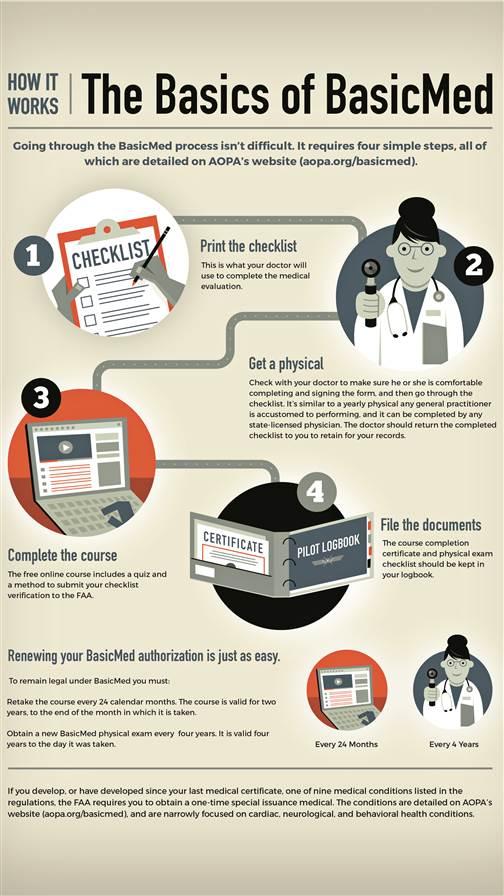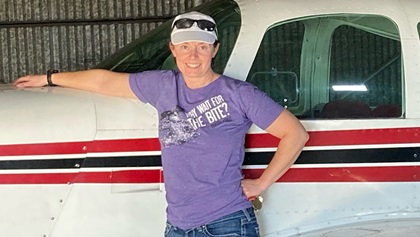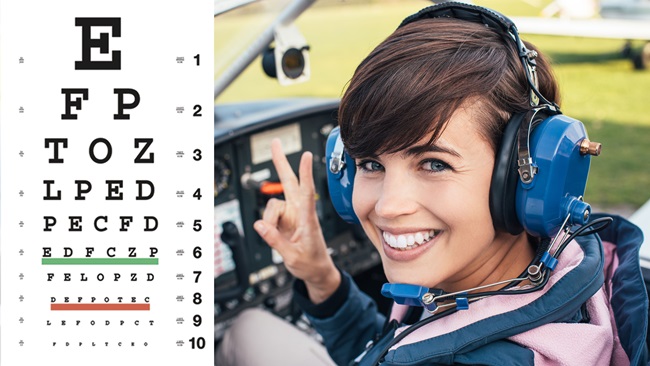Five years later: Just between you and me
BasicMed keeps medical qualifications between you and your personal physician

 On July 15, 2016, Congress passed what would soon be known as BasicMed, an alternative pathway to medical qualification that AOPA and the rest of the general aviation community had in one form or another been championing for decades. Since then, tens of thousands of pilots have come back to flying or decided to continue flying, in no small part because their most important private medical conversations can now take place between them and their personal physician. It has made obtaining the medical clearance to fly more convenient, more economical, and, it could be argued, significantly more effective.
On July 15, 2016, Congress passed what would soon be known as BasicMed, an alternative pathway to medical qualification that AOPA and the rest of the general aviation community had in one form or another been championing for decades. Since then, tens of thousands of pilots have come back to flying or decided to continue flying, in no small part because their most important private medical conversations can now take place between them and their personal physician. It has made obtaining the medical clearance to fly more convenient, more economical, and, it could be argued, significantly more effective.
The push for medical reform began almost as soon as third class medicals were required decades ago for pilots flying for noncommercial purposes. These efforts took various forms over the years, including simply having a state driver’s license in lieu of an FAA medical certificate, which is currently the requirement for sport pilots. But significant, comprehensive reform remained elusive.
That was the situation Mark Baker was handed when he took over the role of AOPA president and CEO in 2013. The FAA and Department of Transportation had been sitting on the request for years, with little to no movement. “Unfortunately, decades of effort didn’t bear much fruit and Mark Baker decided to change things. In reality, it was well past time to take this matter to Congress for action and Mark knew that,” said Jim Coon, AOPA’s senior vice president of government affairs
Through his years of service as a senior committee staffer working on Capitol Hill, his insight and understanding of the legislative process, and the relationship’s he’d built, Coon was able to get in front of members of Congress and their staffs and educate them on the need for and the benefits of medical certification reform.
“There’s nothing hard or complicated about BasicMed. Spend a few minutes with our online resources and I think most pilots will understand the process.” —Gary Crump, AOPAOver the course of about two years, Coon and his team, working alongside key supporters in Congress such as Sen. James Inhofe of Oklahoma, were able to get more than 70 bipartisan Senate co-sponsors on a reform bill, and broad support in the House of Representatives. “When Senator Inhofe agreed to take the lead in the Senate, I knew we were going to get it done,” Coon said. “His knowledge as a GA pilot, his professional persistence, his ability to work with both Republicans and Democrats, and and passion for flying gave me every confidence of the outcome.”
President Barack Obama signed medical certificate reform into law on July 15, 2016, as part of an FAA bill. Although the law did not include a driver’s license standard, it did include a compromise that requires only a one-time FAA medical issuance for every BasicMed pilot.
On May 1, 2017, a few months ahead of the deadline imposed by the law, the FAA solidified BasicMed as regulation. “The FAA’s implementation of BasicMed was exemplary,” Coon said. “The FAA essentially took the statutory language verbatim and wrote the regulation. That’s how well thought out the legislation was.”
What is it?
BasicMed is an alternative pathway from traditional medical certification. Instead of seeing an aviation medical examiner, pilots who elect to fly with BasicMed work with a state licensed physician to go through a medical checklist every four years, and then take an online course covering various aeromedical topics every two years. Every medical certificate has various privileges and limitations, and so does BasicMed. By flying with a BasicMed qualification, a pilot is limited to a six-place airplane, and five passengers, with a maximum takeoff weight of 6,000 pounds, and can fly up to 250 knots and up to 18,000 feet msl, day or night.
Who is eligible?
Any pilot who is comfortable flying with the aircraft and operating limitations may decide to fly with BasicMed in lieu of a traditional medical certificate, provided they meet a few basic requirements. They must have held at least one valid FAA medical certificate since July 14, 2006, and your most recent medical must not have been revoked or denied. If you held a medical certificate that was valid on July 14, 2006, or later, you don’t need to see an AME. However, if your most recent medical certificate expired prior to that date, or you’ve never had an FAA medical certificate, you must see an AME and obtain a one-time third class medical certificate. Also, the FAA requires pilots to obtain a one-time special-issuance medical if he or she develops certain medical conditions.
How do I complete BasicMed?
To be legal under BasicMed, you must first have a physical exam with a state-licensed physician, who must use and sign an FAA checklist. Then you must take an online self-assessment course on aeromedical factors and upload some data to the FAA upon completing the course.
What are the limitations?
To fly with BasicMed, the aircraft must be certificated for six or fewer occupants with a maximum takeoff weight of 6,000 pounds or less. You can’t carry more than five passengers, fly higher than 18,000 feet, or exceed 250 knots, and it should go without saying that you can’t fly for compensation or hire. (Flight instruction is allowed and the CFI may be compensated for the instruction.) That’s it!
Personal responsibility
To date, more than 64,000 pilots have completed the online education course to qualify to fly under BasicMed. The course is available on AOPA online (aopa.org/basicmed), and covers various aeromedical topics. The Mayo Clinic also offers an online course.
The process to qualify under BasicMed isn’t difficult, but there are enough differences between it and traditional medical certification that pilots need to spend just a few minutes familiarizing themselves with the steps.
Gary Crump runs AOPA’s medical certification support team, and his staff fields thousands of calls a year from pilots with questions and concerns about all types of medical certification.
“There’s nothing hard or complicated about BasicMed,” Crump said. “Spend a few minutes with our online resources and I think most pilots will understand the process.” Any lingering questions and Crump suggests calling for clarification.
Although some critics of BasicMed were skeptical, accident data has shown that BasicMed is safe. In fact, the GA accident rate is at its lowest level in decades and medical incapacitation continues to be an exceedingly rare event. When you consider that BasicMed relies on the same principle of medical self-assessment under FAR Par 61.53 as traditional medicals, this makes sense. Every pilot is responsible for personally evaluating his or her medical fitness on every flight, regardless of the type of medical certificate held.
“This is a very safe and very educational program,” Coon said. “Pilots may continue the sound practice of discussing their medical issues with the physician, without having to go through a bureaucratic nightmare that is often very time consuming and costly.” Whether the pilot’s motivation is time, cost, convenience, or a desire to have a more thorough medical exam with their private doctor, BasicMed can help. It’s no wonder so many pilots have chosen it as their path to the cockpit.
Email [email protected]
 At first glance you wouldn’t think the Hampton Roads area of southeastern Virginia would have a shortage of aviation medical examiners. But Hesham Oubari said it’s been getting increasingly difficult to find one. That, and the fact that he can roll his physical exam up through his medical insurance made the decision to switch to BasicMed easy for the Cessna 172 owner. “The convenience factor of dealing with my normal doctor is a far better deal,” he said. Now instead of having to go to another city, Oubari drives two miles to see his normal doctor. She had no hesitation completing the physician checklist, and saw it as a typical and thorough physical exam. Oubari takes the self-certification responsibility seriously, and grounds himself when he doesn’t feel well. “For the type of flying I’m doing, I have absolutely no incentive to go back to third class.” —IJT
At first glance you wouldn’t think the Hampton Roads area of southeastern Virginia would have a shortage of aviation medical examiners. But Hesham Oubari said it’s been getting increasingly difficult to find one. That, and the fact that he can roll his physical exam up through his medical insurance made the decision to switch to BasicMed easy for the Cessna 172 owner. “The convenience factor of dealing with my normal doctor is a far better deal,” he said. Now instead of having to go to another city, Oubari drives two miles to see his normal doctor. She had no hesitation completing the physician checklist, and saw it as a typical and thorough physical exam. Oubari takes the self-certification responsibility seriously, and grounds himself when he doesn’t feel well. “For the type of flying I’m doing, I have absolutely no incentive to go back to third class.” —IJT Diagnosed with cancer at age 38, Trista Becker knew she had to take a break from flying. She and her husband are both pilots who live in a remote part of New Mexico. Like all pilots would do in her situation, she self-grounded during her treatment, and focused on healing. Now two years later, she’s feeling great and ready to get back into the air. Although the FAA does have a special issuance pathway for cancer survivors, Becker found BasicMed to be easier and more convenient. Her oncologist is intimately familiar with her current medical status, and agreed to sign off the physician checklist. BasicMed allows Becker to see her personal doctor, and avoid the expensive and repetitive tests the FAA requires for special issuance that her doctor doesn’t think she needs. It also lets her avoid a three-and-a-half-hour drive to the nearest aviation medical examiner. “I’m doing fine and feeling good,” she said. —IJT
Diagnosed with cancer at age 38, Trista Becker knew she had to take a break from flying. She and her husband are both pilots who live in a remote part of New Mexico. Like all pilots would do in her situation, she self-grounded during her treatment, and focused on healing. Now two years later, she’s feeling great and ready to get back into the air. Although the FAA does have a special issuance pathway for cancer survivors, Becker found BasicMed to be easier and more convenient. Her oncologist is intimately familiar with her current medical status, and agreed to sign off the physician checklist. BasicMed allows Becker to see her personal doctor, and avoid the expensive and repetitive tests the FAA requires for special issuance that her doctor doesn’t think she needs. It also lets her avoid a three-and-a-half-hour drive to the nearest aviation medical examiner. “I’m doing fine and feeling good,” she said. —IJT

